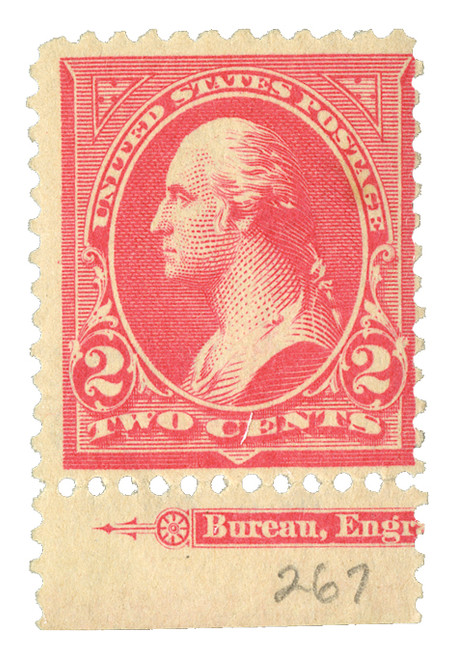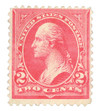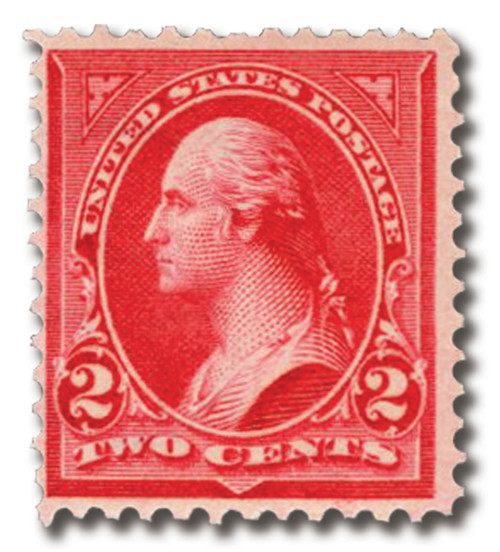
1897 2c Washington, pink, double line watermark, type IV
# 279Bg - 1897 2c Washington, pink, double line watermark, type IV
$65.00 - $290.00
U.S. #279Bf Pink
Series of 1898-99 2¢ Washington
Universal Postal Union Colors
Series of 1898-99 2¢ Washington
Universal Postal Union Colors
Issued: May 1898
Issue Quantity: 12,000,000,000 (estimate)
Printed by: Bureau of Engraving and Printing
Watermark: Double line USPS
Perforation: 12
Color: Pink
This 2¢ Washington stamp paid the domestic letter rate. At the time U.S. #279B was current, the U.S. was still involved in the Spanish-American War and its aftermath. The U.S. had Military Stations in occupied Spanish Colonies. In April, 1898, the U.S. Postmaster General prohibited all mail between our country and Spain, including its colonies.
Issue Quantity: 12,000,000,000 (estimate)
Printed by: Bureau of Engraving and Printing
Watermark: Double line USPS
Perforation: 12
Color: Pink
This 2¢ Washington stamp paid the domestic letter rate. At the time U.S. #279B was current, the U.S. was still involved in the Spanish-American War and its aftermath. The U.S. had Military Stations in occupied Spanish Colonies. In April, 1898, the U.S. Postmaster General prohibited all mail between our country and Spain, including its colonies.
Two months later, he reversed his order to allow mail to and from service personnel serving in the Spanish colonies. To simplify matters, the three war regions were considered to be branches of selected Post Offices in the continental U.S. The Philippine war theater was handled as a branch of the San Francisco Post Office. Cuba was treated as a branch of the New York office, and Puerto Rico as part of the Washington, D.C. Post Office.
Postal customers who were actually service personnel – or closely connected to them – could send mail for the domestic rate of 2¢ per half ounce. Civilians were required to pay the international rate of 5¢ per half ounce.
After the war ended, U.S. #279B was also overprinted for use in the Philippines, Puerto Rico and Cuba.
Why the Series of 1898-99 Was Produced
In 1863, Lincoln’s Postmaster General Montgomery Blair suggested an international conference be held to discuss common postal problems. A conference was held in Paris, and fifteen nations attempted to establish guidelines for an international postal service. Until this time, mail had been regulated by a number of different agreements that were binding only to signing members.
Although Blair did not intend to create a permanent organization, another conference was held 11 years later in Bern, Switzerland. Twenty-two nations, comprising the International Postal congress, drafted and signed the Bern Treaty, which established the General Postal Union. Under this treaty, member nations, including Europe, Britain, and the United States, standardized postal rates and units of weight. They also set forth procedures for transporting ordinary mail. Ordinary mail included letters, postcards, and small packages. Separate rules govern the transportation of items, such as parcel post, newspapers, magazines, and money orders.
Under this agreement, known as the International Postal Convention, a simpler accounting system was devised as well. Previously, countries could vary the international rate. Any mail traveling across a country’s border was charged this rate. In addition, many countries charged a 1¢ surtax for mail being transported by sea for more than 300 miles. Using the basic idea that every letter generates a reply, the Convention allowed each country to keep the postage it collected on international mail. However, that country would then reimburse other members for transporting mail across their borders. The benefits to member nations included lower postal rates, better service, and a more efficient accounting system.
In 1878, at the second conference, the name was changed to the Universal Postal Union (UPU). It wasn’t until the 1880s that the organization became truly universal. By the 1890s, nearly every nation had become a member. In 1947, the UPU became a specialized agency of the United Nations. Today, it continues to organize and improve postal service throughout the world. It’s the oldest international organization existing and claims to be the only one that really works.
In 1898, the Universal Postal Union standardized the colors of certain stamps in order to make international mailing easier and more efficient. They proposed that member nations use the same colors for stamps of the same value. In order to conform to the UPU’s regulations, the 1¢, 2¢, and 5¢ stamps underwent color changes. Later that same year, the 4¢, 6¢, 10¢, and 15¢ stamps were changed to avoid confusion with current issues printed in similar colors.
U.S. #279Bf Pink
Series of 1898-99 2¢ Washington
Universal Postal Union Colors
Series of 1898-99 2¢ Washington
Universal Postal Union Colors
Issued: May 1898
Issue Quantity: 12,000,000,000 (estimate)
Printed by: Bureau of Engraving and Printing
Watermark: Double line USPS
Perforation: 12
Color: Pink
This 2¢ Washington stamp paid the domestic letter rate. At the time U.S. #279B was current, the U.S. was still involved in the Spanish-American War and its aftermath. The U.S. had Military Stations in occupied Spanish Colonies. In April, 1898, the U.S. Postmaster General prohibited all mail between our country and Spain, including its colonies.
Issue Quantity: 12,000,000,000 (estimate)
Printed by: Bureau of Engraving and Printing
Watermark: Double line USPS
Perforation: 12
Color: Pink
This 2¢ Washington stamp paid the domestic letter rate. At the time U.S. #279B was current, the U.S. was still involved in the Spanish-American War and its aftermath. The U.S. had Military Stations in occupied Spanish Colonies. In April, 1898, the U.S. Postmaster General prohibited all mail between our country and Spain, including its colonies.
Two months later, he reversed his order to allow mail to and from service personnel serving in the Spanish colonies. To simplify matters, the three war regions were considered to be branches of selected Post Offices in the continental U.S. The Philippine war theater was handled as a branch of the San Francisco Post Office. Cuba was treated as a branch of the New York office, and Puerto Rico as part of the Washington, D.C. Post Office.
Postal customers who were actually service personnel – or closely connected to them – could send mail for the domestic rate of 2¢ per half ounce. Civilians were required to pay the international rate of 5¢ per half ounce.
After the war ended, U.S. #279B was also overprinted for use in the Philippines, Puerto Rico and Cuba.
Why the Series of 1898-99 Was Produced
In 1863, Lincoln’s Postmaster General Montgomery Blair suggested an international conference be held to discuss common postal problems. A conference was held in Paris, and fifteen nations attempted to establish guidelines for an international postal service. Until this time, mail had been regulated by a number of different agreements that were binding only to signing members.
Although Blair did not intend to create a permanent organization, another conference was held 11 years later in Bern, Switzerland. Twenty-two nations, comprising the International Postal congress, drafted and signed the Bern Treaty, which established the General Postal Union. Under this treaty, member nations, including Europe, Britain, and the United States, standardized postal rates and units of weight. They also set forth procedures for transporting ordinary mail. Ordinary mail included letters, postcards, and small packages. Separate rules govern the transportation of items, such as parcel post, newspapers, magazines, and money orders.
Under this agreement, known as the International Postal Convention, a simpler accounting system was devised as well. Previously, countries could vary the international rate. Any mail traveling across a country’s border was charged this rate. In addition, many countries charged a 1¢ surtax for mail being transported by sea for more than 300 miles. Using the basic idea that every letter generates a reply, the Convention allowed each country to keep the postage it collected on international mail. However, that country would then reimburse other members for transporting mail across their borders. The benefits to member nations included lower postal rates, better service, and a more efficient accounting system.
In 1878, at the second conference, the name was changed to the Universal Postal Union (UPU). It wasn’t until the 1880s that the organization became truly universal. By the 1890s, nearly every nation had become a member. In 1947, the UPU became a specialized agency of the United Nations. Today, it continues to organize and improve postal service throughout the world. It’s the oldest international organization existing and claims to be the only one that really works.
In 1898, the Universal Postal Union standardized the colors of certain stamps in order to make international mailing easier and more efficient. They proposed that member nations use the same colors for stamps of the same value. In order to conform to the UPU’s regulations, the 1¢, 2¢, and 5¢ stamps underwent color changes. Later that same year, the 4¢, 6¢, 10¢, and 15¢ stamps were changed to avoid confusion with current issues printed in similar colors.













